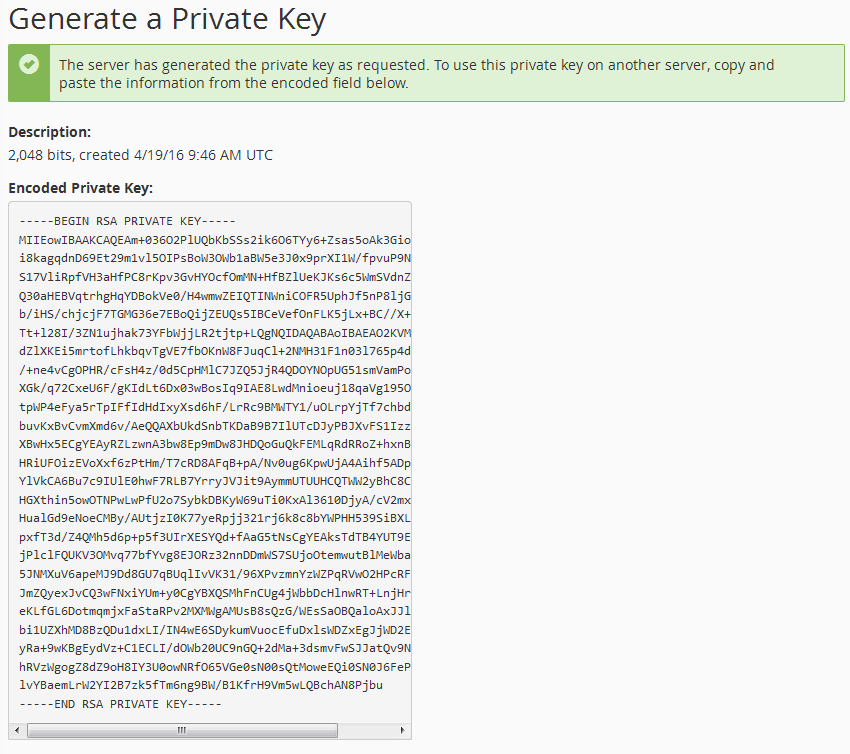.pem SSL Creation Instructions
- Rsa Public Key Example
- Generate Pem Encoded Rsa Public Key From Certificate Pdf
- Generate Pem Encoded Rsa Public Key From Certificate Search
SSL .pem files (concatenated certificate container files), are frequently required for certificate installations when multiple certificates are being imported as one file.
Apr 13, 2020 website to see its certificate in X509 format. Alright, now let’s get back to the terminal and run: openssl req -x509 Then -newkey rsa:4096 This option basically tells openssl to create both a new private key with RSA 4096-bit key, and its certificate request at the same time. As we’re using -x509 option, it will output. Then I uploaded the public.pem to the admin console for the 'PEM encoded X.509 certificate', and uploaded the private.pem for the 'Unencrypted PEM encoded RSA private key'. And that finally worked. A private key that only trusted entities can use to decrypt the information encrypted by its paired public key; When generating a key pair, keep the following guidelines in mind: The application supports SSH protocol version 2 RSA and DSA keys. Keys must be OpenSSH-compatible and PEM-encoded. RSA keys can range between 768 and 16384 bits. Jul 22, 2017 Create a new 4096bit RSA key and save it to serverkey.pem, without DES encryption (-newkey, -keyout and -nodes) Create a Certificate Signing Request for a given subject, valid for 365 days.
This article contains multiple sets of instructions that walk through various .pem file creation scenarios.
Generate a CSR from an Existing Private Key. Openssl req -key domain.key -new -out domain.csr Generate a Self-Signed Certificate from an Existing Private Key. Openssl req -key domain.key -new -x509 -days 365 -out domain.crt here the domain.key is the OpenSSL PEM encoded private key. Assuming you have the SSH private key idrsa, you can extract the public key from it like so. Openssl rsa -in idrsa -pubout -out idrsa.pub.pem I realize the OP asked about converting a public key, so this doesn't quite answer the question, however I thought it would be useful to some anyway. When the PEM format is used to store cryptographic keys the body of the content is in a format called PKCS #8. Initially a standard created by a private company (RSA Laboratories), it became a de facto standard so has been described in various RFCs, most notably RFC 5208 ('Public-Key Cryptography Standards (PKCS) #8: Private-Key Information Syntax Specification Version 1.2').
Creating a .pem with the Entire SSL Certificate Trust Chain
Rsa Public Key Example
- Log into your DigiCert Management Console and download your Intermediate (DigiCertCA.crt), Root (TrustedRoot.crt), and Primary Certificates (your_domain_name.crt).
Open a text editor (such as wordpad) and paste the entire body of each certificate into one text file in the following order:
- The Primary Certificate - your_domain_name.crt
- The Intermediate Certificate - DigiCertCA.crt
- The Root Certificate - TrustedRoot.crt
Make sure to include the beginning and end tags on each certificate. The result should look like this:
-----BEGIN CERTIFICATE-----
(Your Primary SSL certificate: your_domain_name.crt)
-----END CERTIFICATE-----
-----BEGIN CERTIFICATE-----
(Your Intermediate certificate: DigiCertCA.crt)
-----END CERTIFICATE-----
-----BEGIN CERTIFICATE-----
(Your Root certificate: TrustedRoot.crt)
-----END CERTIFICATE-----Save the combined file as your_domain_name.pem. The .pem file is now ready to use.
Creating a .pem with the Server and Intermediate Certificates
- Log into your DigiCert Management Console and download your Intermediate (DigiCertCA.crt) and Primary Certificates (your_domain_name.crt).
Open a text editor (such as wordpad) and paste the entire body of each certificate into one text file in the following order:
- The Primary Certificate - your_domain_name.crt
- The Intermediate Certificate - DigiCertCA.crt
Make sure to include the beginning and end tags on each certificate. The result should look like this:
-----BEGIN CERTIFICATE-----
(Your Primary SSL certificate: your_domain_name.crt)
-----END CERTIFICATE-----
-----BEGIN CERTIFICATE-----
(Your Intermediate certificate: DigiCertCA.crt)
-----END CERTIFICATE-----Save the combined file as your_domain_name.pem. The .pem file is now ready to use.
Creating a .pem with the Private Key and Entire Trust Chain
- Log into your DigiCert Management Console and download your Intermediate (DigiCertCA.crt) and Primary Certificates (your_domain_name.crt).
Open a text editor (such as wordpad) and paste the entire body of each certificate into one text file in the following order:
- The Private Key - your_domain_name.key
- The Primary Certificate - your_domain_name.crt
- The Intermediate Certificate - DigiCertCA.crt
- The Root Certificate - TrustedRoot.crt
Make sure to include the beginning and end tags on each certificate. The result should look like this:
-----BEGIN RSA PRIVATE KEY-----
(Your Private Key: your_domain_name.key)
-----END RSA PRIVATE KEY-----
-----BEGIN CERTIFICATE-----
(Your Primary SSL certificate: your_domain_name.crt)
-----END CERTIFICATE-----
-----BEGIN CERTIFICATE-----
(Your Intermediate certificate: DigiCertCA.crt)
-----END CERTIFICATE-----
-----BEGIN CERTIFICATE-----
(Your Root certificate: TrustedRoot.crt)
-----END CERTIFICATE-----Save the combined file as your_domain_name.pem. The .pem file is now ready to use.
Common OpenSSL Commands with Keys and Certificates
Generate RSA private key with certificate in a single command
Generate Certificate Signing Request (CSR) from private key with passphrase
Generate RSA private key (2048 bit)

